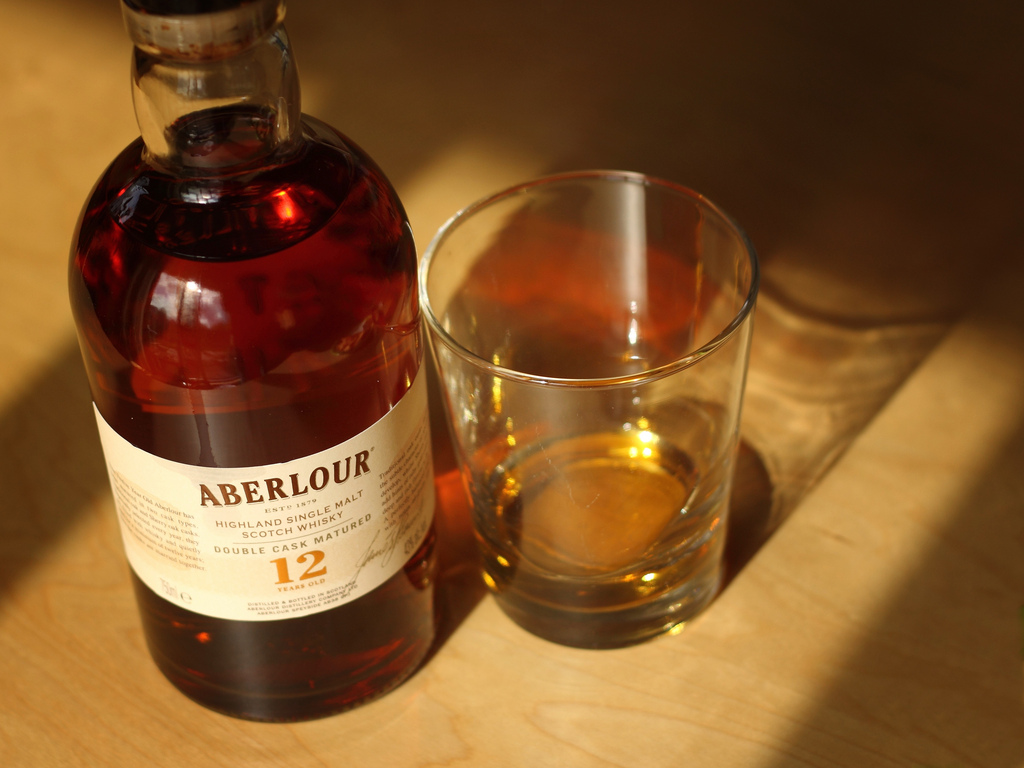Starter Scotches Part II – Aberlour 12 Year Old
Uncategorized
So if you’ve been following our blog you’ll know that we thought it wise to start a series on starter scotches. We figured that we should give our readers that aren’t so familiar with chill-filtration, 24 Year Olds and obscure indie bottlings something to get their teeth into.
We got a bit of flack on social media for part one of this series, mainly because we chose the all-powerful and peat heavy Lagavulin 16 as our first bottle. We still stand by that decision, and think it’s a great entry point for new whisky drinkers (offering them a perfect example of the power and flavours that can be stored inside a bottle) but we also realise that it might not be for everyone.
With that in mind, in part II we are going to go for something that is a whole lot smoother, slightly easier to understand and lacking in the smack to the chops that is delivered by the Lagavulin (sorry to disappoint peat-lovers everywhere). Our choice of tipple this time is…
The Aberlour 12 Year Old
This beautiful Speyside whisky brings a lot of the characteristics that you would expect from the region – it’s rich, sweet, smooth and fruity.
The best thing is – it manages to deliver them in the most pleasant and enjoyable of ways. It’s not rough around the edges, it’s not too aggressive, and it’s certainly not too complex for beginners to understand.
Simply put, it’s a fantastic entry point and one that has become a staple of thousands of whisky-lovers round the globe.
Trying your first dram of Aberlour 12
So you’ve got your bottle and your nosing glass in front of you, you’ve poured yourself a dram and you’re ready to test it out. What should you be looking for?
Nosing
The first thing that you’ll notice when you bring this dram up for a sniff is the alcohol. This isn’t even a particularly high percentage whisky, coming in at just 40% ABV, but this always tends to happen if you’re a relative newbie (unless you’ve gone for a peated scotch). Don’t worry though, this is simply because your nose hasn’t been given time to acclimatise to the spirit yet.
Take it away and bring it back up for another sniff.
You might have to do this several times, but before long you’ll start to detect a richness in the form of dark fruits and raisins. This dram has been matured in a mix of traditional oak and Sherry casks and these wintry notes are definitely a product of the latter.
As the whisky sits in the glass it will start to ‘open up’ (whisky lingo for notes becoming more apparent) and you might find that you start to smell subtle hints of vanilla and apples. These come from the traditional oak.
This combination of rich and sweet may sound confused, but you’ll find that this bottle is so well balanced that they compliment each other perfectly.
Tasting
Now it’s time to take a sip. Go on, take one. That’s better. What do you taste?
More richness? Hints of fruitcake, dark currants and cherries? Spot on, well done.
If you’re not detecting these just yet, don’t worry, give yourself time (or drink enough of it that you can convince yourself that you’re detecting things).
After a couple of sips you’ll notice that there is a slight burn of the alcohol that comes through just before you swallow. This is probably down to the fact the dram is relatively young. Casks help to iron out these imperfections by imparting their own flavours and in this case they haven’t had quite enough time to fully complete the process.
Finish
By this point you’re probably shouting “I thought you said this was matured in traditional oak casks too! Where’s the oak?” Well, oaky flavours are well known for arriving late to the party and the Aberlour 12 is a perfect example of this.
More fruitcake, a touch of cinnamon and then the oak show themselves on the finish and to delightful effect. What’s more, these flavours linger for a half-decent length of time, meaning you can savour every last drop of your dram.
Overall
The Aberlour 12 is smooth and not too aggressive but also full of flavour, making it perfect for a newbie looking to develop a grounding in Speyside whisky. But that’s not all it brings to the table.
This whisky acts as a kind of whisky tutorial all by itself, taking you from Sherry cask to Oak cask and letting you experience the combination of both in between. In the long run this will set you nicely for the complex range of notes and flavour combinations that you are yet to experience on your journey into the world of whisky.




Lovely description. I’m sitting with a dram of this and got everything promised.
I’m a Lagavulin man but I can learn to enjoy this. Without the help I would’ve dismissed it as vaporous and light. Now I get it.